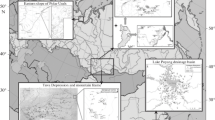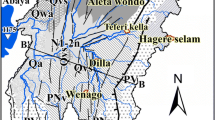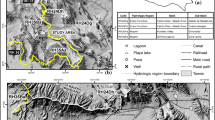Abstract
Three major, interdependent processes control the genesis and distribution of mineral and thermal waters in the Rhenish Massif, Central Europe: (a) Magmatic processes in the upper mantle provide most of the CO2 to produce bicarbonate waters in shallow aquifers. (b) Extension of the brittle upper crust enables the ascent of sodium chloride waters. (c) Uplift and erosion shape the massif's relief, which determines the extent of flow systems and the distribution of thermal springs. The chemistry of mineral waters further depends on the aquifers' mineral composition. A comprehensive set of hydrological, chemical, tectonic and geophysical data on the Rhenish Massif has been compiled. It was used to classify the mineral waters and to map the spatial distribution of water properties. The composition of cuttings from several representative wells producing different water types shows that the hydrothermal alteration of the aquifer rocks consists mainly of kaolinization of chlorite and dissolution of feldspar. Numerical transport simulations favour two modes of groundwater flow: topography-driven flow and the pressure-driven ascent of basement brines along active faults. Thermal convection is less important.
Similar content being viewed by others
References
Ahorner L (1983) Historical seismicity and present day microearthquake activity of the Rhenish Massif, Central Europe. In: Fuchs K et al. (eds) Plateau uplift. Springer, Berlin Heidelberg New York, pp 198–221
Althaus E, Walther J, Holl A (1995) Das Kontinentale Tiefbohrprogramm und die Fluidforschung. Geowissenschaften 13:147–153
Becker A (1993) An attempt to define a “Neotectonic Period” for Central and Northern Europe. Geol Rundsch 82:67–83
Behr H, Gerler J (1987) Inclusions of sedimentary brines in post-Variscan mineralizations in the Federal Republic of Germany — a study by neutron activation analysis. Chem Geol 61:65–77
Behr H, Gerler J, Hein UF, Reutel CJ (1993) Tectonic Brines und Basement Brines in den mitteleuropäischen Varisziden: Herkunft, metallogenetische Bedeutung und geologische Aktivität. Göttinger Arb Geol Paläont 58:3–28
Blundell DJ (1990) Seismic images of the continental lithosphere. J Geol Soc 147:895–913
Boom G von der, Krimmel H (1986): Geochemiche Untersuchungen im Gebiet Lohrheim/Lahn unter Verwendung gasförmiger Elemente und Verbindungen. Geol Jb D81:3–19
Bruhn RL (1992) Fracture networks in fault zones — controls on fluid transport, chemical alteration and fault mechanics. Abstr 29th Int Geol Congr, p. 166
Byerlee J (1993) Model for episodic flow of high-pressure water in fault zones before earthquakes. Geology 21:303–306
Carlé W (1975) Die Mineral- und Thermalwässer von Mitteleuropa. Wissenschaftl Verlagsges, Stuttgart, pp 1–643
Cathles LM (1990) Scales and effects of fluid flow in the upper crust. Science 248:323–329
Clauser C (1988) Untersuchungen zur Trennung der konduktiven und konvektiven Anteile im Wärmetransport in einem Sedimentbecken am Beispiel des Oberrheintalgrabens. Forsch Ber VDI Reihe 19 Nr 28:1–134
Cloos H (1939) Hebung, Spaltung, Vulkanismus. Elemente einer geometrischen Analyse irdischer Grossformen. Geol Rundsch 30:401–519
DEKORP Research Group (1990) Results of deep seismic reflection investigations in the Rhenish Massif. Tectonophysics 173:507–515
Erft Verband (1992) Jahresbericht 1992. Berghein, pp 1–108
Felix-Henningsen P (1990) Die mesozoisch-tertiäre Verwitterungsdecke (MTV) im Rheinischen Schiefergebirge. Aufbau, Genese und quartäre Oberprägung. Relief Boden Paläoklima 6:1–192
Flehmig W (1983) Mineralogical composition of pelitic sediments in the Rhenohercynian zone. In: Martin H, Eder FW (eds) Intracontinental foldbelts. Springer, Berlin Heidelberg New York, pp 257–265
Fontes JC, Matray JM (1993) Geochemistry of formation brines from the Paris Basin, France. Chem Geol 109:149–200
Fournier RO, Potter RW II (1979) Magnesium correction to the Na-K-Ca chemical geothexmometer. Geochim Cosmochim Acta 43:1543–1550
Franke W, Bortfeld RK, Brix M, Drozdzewski G, Dürrbaum HJ, Giese P, Janoth P, Jödicke H, Reichert C, Scherp A, Schmoll J, Thomas R, Thünker M, Weber K, Wiesner MG, Wong HK (1990) Crustal structure of the Rhenish Massif: results of deep seismic reflection lines DEKORP 2-North and DEKORP 2-North-Q. Geol Rundsch 79:523–566
Fricke K (1974) Die Thermalwasserbohrung 1973 in St. Augustin/ Raum Bonn. Brunnenbau, Bau von Wasserwerken, Rohrleitungsbau 25:155–158
Fricke K (1977) Zur Hydrogeologie, Hydrochemie und Geothermik der neuen Thermalbohrung in Bad Neuenahr 1975/76 unter besonderer Berücksichtigung des angetroffenen Basaltganges. Heilbad Kurort 77:8–19
Fricke K, Deutloff O (1964) Die geologischen und hydrologischen Ergebnisse der Mineralwasserneubohrung “Gartenstrasse” in Bad Godesberg 1961/62. Gas Wasserfach 105:305–311
Fuchs K, Gehlen K von, Mälzer H, Murawski H, Semmel A (eds) (1983) Plateau uplift. The Rhenish Shield: a case history. Springer, Berlin Heidelberg New York, pp 1–411
Giggenbach WF (1988) Geothermal solute equilibria. derivation of Na-K-Mg-Ca geoindicators. Geochim Cosmochim Acta 52:2749–2765
Giggenbach WF, Gonfiantini R, Jangi BL, Truesdell AH (1983) Isotopic and chemical composition Parbati Valley geothermal discharges, NW Himalaya, India. Geothermics 12:199–222
Giggenbach WF, Sano Y, Schmincke HU (1991) CO2-rich gases from lakes Nyos, Cameroon; Laacher See, Germany; Dieng, Indonesia; and Mt. Gambier, Australia — variation on a common theme. J Vocanol Geotherm Res 45:311–323
Grabert H (1994) Tektogenese und Mineralisation im Rheinischen Schiefergebirge. Decheniana 147:179–192
Griesshaber E, O'Nions RK, Oxburgh ER (1992) Helium and carbon isotope systematics in crustal fluids from the Eifel, the Rhine Graben and Black Forest, FRG. Chem Geol 99:213–235
Grünthal G, Stromeyer D (1992) The recent crustal stress field in Central Europe: trajectories and finite element modelling. J Geophys Res 97 (B8): 11805–11820
Hanel R (1983) Geothermal investigations in the Rhenish Massif. In: Fuchs K et al. (eds) Plateau uplift. Springer, Berlin Heidelberg New York, pp 228–246
Heyl KE, Nielsen H, Rambow D (1970) Die S-Isotopenverteilung im Sulfatschwefel von Mineralwässern aus dem Moselgebiet, dem Mainzer Becken, dem westlichen Oberrheingraben und dem Nahegebiet. Notizbl Hess Landesamt Bodenforsch 98:249–254
Holl HG (1995) Die Siliziklastika des Unterdevon im Rheinischen Trog (Rheinisches Schiefergebirge). Detritus-Eintrag und P,T-Geschichte. Dissertation, University of Bonn, pp 1–164
Hölting B (1977) Bemerkungen zur Herkunft der Salinarwässer am Taunusrand. Geol Jb Hessen 105:211–221
Hummel K (1930) Beziehungen der Mineralquellen Deutschlands zum jungen Vulkanismus. Z pr Geol 38:1–8, 20–24
Hutcheon I (1984) A review of artificial diagenesis during thermally enhanced recovery. AAPG Mem 37:413–429
Kharaka YK, Mariner RH (1989) Chemical geothermometers and their application to formation waters from sedimentary basins. In: Naeser ND, McCulloh TH (eds) Thermal history of sedimentary basins. Springer, Berlin Heidelberg New York, pp 99–117
Knetsch G (1939) Kohlensäure, Vulkanismus und Erzlagerstätten des Rheinischen Schiefergebirges (eine Karte tektonisch-magmatischer Konsequenzen). Geol Rundsch 30:777–789
Krahn L (1988) Buntmetall-Vererzung und Blei-Isotopie im Linksrheinischen Schiefergebirge und in angrenzenden Gebieten. Dissertation, TH Aachen, 199 pp
Langguth HR, Plum H (1983) Research of geothermal anomalies by means of hydrochemical data in the East Eifel area, West Germany. Geothermics 12:233–239
Laube N, Hergarten S, Neugebauer HJ (1996) MODUSCALC —a computer program to calculate a mode from a geochemical rock analysis. Comp Geosci (in press)
Matthews A, Fouillac C, Hill R, O'Nions RK, Oxburgh ER (1987) Mantle-derived volatiles in the continental crust: the Massif Central of France. Earth Planet Sci Lett 85:117–128
May F (1993) Origin of mineral waters in the Rhenish Massif; analytical and numerical results. In: Banks S, Banks D (eds) Hydrogeology of hard rocks. Geol Surv Norway, Trondheim, pp 498–506
May F (1994a) Zur Entstehung der Mineralwässer des Rheinischen Massifs. Dissertation, University of Bonn, pp 1–136
May F (1994b) Weathering or hydrothermal alteration? Examples from the Rhenish Massif, Germany. Mineral Mag 58A:577–578
McKenzie D (1994) Melt movement in the mantle. Mineral Mag 58A:585–586
Meissner R, Wever T, Sadowiak P (1990) Reflectivity patterns in the Variscan mountain belt and adjacent areas: an attempt for a pattern recognition and correlation to tectonic units. Tectonophysics 173:361–378
Mengel K, Sachs PM, Stosch HG, Wörner G, Loock G (1991) Crustal xenoliths from the Cenozoic volcanic fields of West Germany: implications for structure and composition of the continental crust. Tectonophysics 195:271–289
Parkhurst DL, Thorstenson DC, Plummer LN (1983) PHREEQE A computer program for geochemical calculations. USGS Water Resources Inv 80–96, pp 1–210
Plenefisch T, Bonjer KP (1994) The stress tensor in the Rhine Graben area derived from earthquake focal mechanisms (extended abstract). Geol Mijnbouw 73:169–172
Ploschenz C (1994) Quartäre Vertikaltektonik im südöstlichen Schiefergebirge, begründet mit der Lage der jüngeren Hauptterrasse. Dissertation, University of Bonn, pp 1–185
Potdevin JL, Marquer D (1987) Méthodes de quantificacion des transferts de matière par les fluides dans les roches métamorphiques déformées. Geochim Acta 1987:193–206
Plum H (1989) Genetische Klassifikation und geochemische Interpretation der Mineral- und Thermalwässer der Eifel und Ardennen. Mitt Ing Hydrogeol 34:1–170
Raikes S, Bonjer KP (1983) Large-scale mantle heterogeneity beneath the Rhenish Massif and its vicinity from teleseismic Presiduals measurements. In: Fuchs K et al. (eds) Plateau uplift. Springer, Berlin Heidelberg New York, pp 315–331
Redecke P (1992) Zur Geochemie und Genese variszischer und postvariszischer Buntmetallmineralisation in der Nordeifel und der Niederrheinischen Bucht. Dissertation, TH Aachen, pp 1–152
Riley TR, Bailey DK, Lloyd FE, Fenwick CS, Palmer MR (1994) Carbonate metasomatism in the Eifel (Germany) sub-continental lithosphere: geochemical and isotopic signature. Mineral Mag 58A: 776–777
Schiano P, Clocchiatti R, Shimizu N (1994) Melt inclusions trapped in mantle minerals: a clue to identifying metasomatic agent in the upper mantle beneath continental and oceanic intraplate regions. Mineral Mag 58A: 807–808
Schmincke HU, Van den Boogard P, Freundt A (1990) Quaternary Eifel volcanism. Excursion Int Volcanological Congr Mainz, pp 1–188
Schwanbeck K (1992) C- und O-Isotopenuntersuchungen an Siderit-Konkretionen aus Oberems-Schichten der Moselmulde. Dissertation, University of Bonn, pp 1–92
Spelter M (1978) Zur Hydrogeologie, Hydrochemie und Hydrothermie der südlichen Niederrheinischen Bucht, insbesondere des Südteils der Erftscholle. Mitt Ing Hydrogeol 7:1–161
Spera FJ (1984) Carbon dioxide in petrogenesis III: role of volatiles in the ascent of alkaline magma with special reference to xenolith-bearing mafic lavas. Contrib Mineral Petrol 88:217–232
Spera FJ (1987) Dynamics of translithospheric migration of metasomatic fluid and alkaline Magma. In: Mezies MA, Hakesworth CJ (eds) Mantle metasomatism. Academic Press, London, pp 1–20
Spies ED (1986) Vergleichende Untersuchungen an präpleisto-zänen Verwitterungsdecken im Osthunsrück und an Gesteinszersatz durch aszendente (Thermal-) Wässer in der Nordosteifel (Rheinisches Schiefergebirge). Dissertation, University of Bonn, pp 1–182
Stengel-Rutkowski W (1987) Die Säuerlinge des Westtaunus Nachzügler eines neogenen Vulkanismus oder Vorboten künftiger tektonischer Aktivität? Geol Jb Hessen 115:331–340
Thilbault Y, Holloway JR (1994) Solubility of CO2 in a Ca-rich leucitite: effects of pressure, temperature and oxygen fugacity. Contrib Mineral Petrol 116:216–224
Torgerson T, Clarke WB (1992) Geochemical constraints on formation fluid ages, hydrothermal heat flux and Custal mass transport mechanisms at Cajon Pass. J Geophys Res 97 (B4):5031–5038
Trappe H, Wever T (1990) Seismic evidence of increased tectonothermal activity near the Oberpfalz deep continental drilling location (SE Germany). Geol Rundsch 79:649–658
Volbers R, Jödicke H, Untiedt J (1990) Magnetotelluric study of the Earth's crust along the deep seismic reflection profile DEKORP 2-N. Geol Rundsch 79:581–601
Wedewardt M (1995) Hydrochemie und Genese der Tiefenwässer im Ruhr-Revier. DMT-Berichte Forschung Entwicklung 39:1–250
Weyer KU (1972) Ermittlung der Grundwassermengen in den Festgesteinen der Mittelgebirge aus den Messungen des Trockenwetterabflusses. Geol Jb C3:19–114
White BS, Wyllie PJ (1992) Solidus reactions in synthetic lherzolite-H2O-CO2 from 20–30 kbar, with applications to melting and metasomatism. J Volcanol Geotherm Res 50:117–130
Wilson M, Downes H (1992) Mafic alkaline magmatism associated with the European Cenozoic rift system. Tectonophysics 208:173–182
Witkowski A, Kowalczyk A (1993) Changes of hydrogeological properties of the carboniferous sandstones with depth in the upper silesian coal basin (Poland). in press
Witt-Eickschen G, Seck HA, Reys C (1992) Multiple enrichment processes and their relationships in the subcrustal Lithosphere beneath the Eifel (Germany) J Petrol 34:1–22
Ziegler PA (1994) Cenozoic rift system of western and cental Europe: an overview. Geol Mijnbouw 73:99–127
Zinngrebe E, Foley S (1995) Metasomatism in mantle xenoliths from Gees, West Eifel, Germany: evidence for the genesis of calc-alkaline glasses and metasomatic Ca-enrichment. Contrib Mineral Petrol 122:79–96
Author information
Authors and Affiliations
Rights and permissions
About this article
Cite this article
May, F., Hoernes, S. & Neugebauer, H.J. Genesis and distribution of mineral waters as a consequence of recent lithospheric dynamics: the Rhenish Massif, Central Europe. Geol Rundsch 85, 782–799 (1996). https://doi.org/10.1007/BF02440111
Received:
Accepted:
Published:
Issue Date:
DOI: https://doi.org/10.1007/BF02440111




